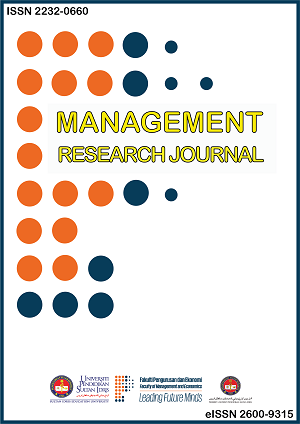The Relationship between Job Satisfaction and Commitment among National School Teachers in South Kinta District, Perak
Hubungan antara Kepuasan Kerja Guru dengan Komitmen Guru Sekolah Kebangsaan di Daerah Kinta Selatan, Perak
DOI:
https://doi.org/10.37134/mrj.vol11.2.1.2022Keywords:
Job Satisfaction, Teachers’ Commitment, School, EducationAbstract
The purpose of this study is to analyze the relationship between job statisfaction and commitment among national school teachers in South Kinta district, Perak. This study used a quantitative approach with a survey design based on a questionnaire. It involves 150 national school teachers from six national schools in Kinta Selatan district, Perak. The selection of schools and respondents were made using simple, stratified and systematic random sampling. Datas were analyzed using descriptive and inferential tests. The findings showed that teachers’ job satisfaction according to teachers’perceptions was at high level (mean = 3.93) while teachers’ commitment was at a high level (mean = 3.96). Next, the study found that there was a significant positive relationship between teachers’ job satisfaction and teachers’ commitment had very strong correlation (r = 0.74**, p < 0.05). In conclusion, teachers’ job satisfaction has a significant relationship with teachers’ commitment in school education management. The Implications of this study show that it is important for teachers to achieve a level of teachers’ job satisfaction to increase the level of teachers’ commitment that creates a school climate and school environment.
Downloads
References
Abdul Rahim Zumrah & Boyle. (2015). The effects of perceived organizational support and job satisfaction on transfer of training. Personnel Review,236-254.
Akpofure, R.R., Ikhifa, O.G., Imide, O.I., & Okokoyo, I.E. (2006). Job satisfaction among educators in Colleges of Education in Southern Nigeria. Journal of Applied Sciences, 1094-1098.
Baptiste, N. (2008). Tightening the link between employee wellbeing at work and perfomancer: A new dimension fo HRM. Management Decision,284-309.
Campell, J. (1970). Managerial Behavior, Performance and Effectiveness. New York: McGraw Hill.
Chua, Y. (2011). Kaedah Penyelidikan. Kuala Lumpur: McGraw Hill (Malaysia) Sdn. Bhd.
Day, C. (2004). A Passion for Teaching. London: Routledge Falmer.
Firestone, W.A. & Pennell, J.R. (1998). Teacher Commitment, Working Conditions, And Differential Incentive Policies. Review of Educational Research, Winter,489-525.
Hassan, A. J. (1996). Hakisan Kerja Guru-Guru di Sekolah Menengah Daerah Muar, Johor. Jitra: Universiti Utara Malaysia.
Jabatan Pendidikan Perak. (2015). Laporan Kes-Kes Dan Masalah Disiplin Guru-Guru Negeri Perak. Ipoh: Unit Pendaftaran dan Perhubungan Perak.
Kamaruddin, Z. (2007). Penglibatan guru dalam membuat keputusan, sokongan organisasi dan komitmen kerja. Gelugor, Pulau Pinang: Penerbit Universiti Sains Malaysia.
Kariming, N. F. (2018). Hubungan Iklim Sekolah terhadap Kepuasan Kerja Guru Tingkatan 6 Zon Pantai Timur Sabah. Jurnal Komunikasi Borneo,53-64.
Kementerian Pendidikan Malaysia. (2016). Pelan Pembangunan Pendidikan Malaysia (PPPM2013-22025). Kuala Lumpur: Bahagian Perancangan dan Penyelidikan Dasar Pendidikan, Kementerian Pendidikan Malaysia.
Khalid, R. (2015). Relationship between principals' transformational leadership style and secondary school teachers' commitment. Asian Social Science,221-228.
Kushman, J. (1992). The Organizational dynamics of teacher workplace commitment: A study of urban elementary and middle schools. Educational Administration Quartely,5-42.
Lewis, M. & Wray, D. (2000). Literacy in the Scondary School. London: David Fulton.
Locke, E. (1976). The Nature and Causes off Job Satisfaction. Chicago: Rand Mc Nally.
Mahmood, H. (2005). Kepimpinan Dan Keberkesanan Sekolah. Kuala Lumpur: Dewan Bahasa dan Pustaka.
Maslow, A. (1970). Motivation and Personality. New York: Haper & Row Publisher Inc. Moore, H. (2012). A study to investigate the relationship between job satisfaction and stress for social care workers in Ireland. Dublin: Dublin Businees School Press.
Mowday, R. (1982). Employee Linkages: The Psychology of Commitment and Absenteeism and Turnover. New York: Academic Press.
Nawai, L. N. (2015). Hubungan Motivasi Terhadap Kepuasan Kerja Pegawai Belia Dan Sukan Negeri Kelantan, Terengganu dan Pahang. Kelantan: Pusat Pengajian Bahasa dan Pembangunan Insaniah, UMK.
Noor Syakirah et. al. (2016). Faktor-faktor mempengaruhi kepuasan kerja dalam kalangan akademik di Universiti Utara Malaysia. Sintok, Kedah: Penerbit Universiti Utara Malaysia.
Pallant, J. (2001). SPSS Survival Guide. Australia: Allen & Unwin.
Raja Nurmunira Raja Harman Shah & Mohamed Yusof Mohd Nor. (2021). Amalan kepimpinan lestari guru besar dan kepuasan kerja guru di Sekolah Kebangsaan Padang Jawa Shah Alam. Jurnal Dunia Pendidikan,385-393.
Reynolds, D. (2002). World Class Schools: International Perspective on School Effectiveness. London: Routledge.
Saidur Rahaman, H. (2012). Organizational commitment, perceived organizational support, and job satisfaction among school teachers: comparing public and private sectors in Bangladesh. South Asian Journal of Management,7-17.
UNESCO. (2011). The Hidden Crisis: Armed Conflict and Education. EFA Global Monitoring Report. http://unesdoc.unesco.org/images/0019/001907/190743e.pdf.
Zainal, A. H. (1993). Hubungan antara Tekanan dan Kepuasan Kerja Dalam Kalangan Pekerja. Jurnal Psikologi,103-121.
Zulkafli, N. & Mahbob, M.H. (2020). Pengaruh Faktor Motivasi terhadap Prestasi Kerja. Jurnal Wacana Sarjana,1-11.





